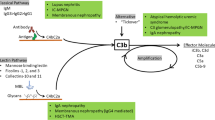Summary
In 12 rabbits with induced experimental Masugi nephritis and in 6 control rabbits the level of 5-HT in whole blood and 5-HIAA excretion in urine/24h were studied. In all animals of the experimental group a significant increase of 5-HT and 5-HIAA was found, which was strictly correlated in time with two-phase immunological reaction occurring in Masugi nephritis. Moreover, the electron microscope examinations showed a distinct thickening of glomerular basement membrane on the 8th day of experiment, i.e., at the time of maximum 5-HT increase in the blood, which according to the literature, can be interpreted as having been caused, if not exclusively, so at least among others, by direct action of endogenous 5-HT.
Similar content being viewed by others
References
Ashcroft, J. K., Crawford, T. B., Binns, J. K., McDougall, E. J.: Estimation of 5-Hydroxytryptamine in human blood. Clin. Chim. Acta9, 364–369 (1964)
Beregi, E., Földes, I., Jankovics, R., Csötörtök, L.: Serotonin-induced renal changes in the rabbit and the rat. Arch. Int. Pharmacol.138, 268–275 (1962)
Bohle, A., Miller, F., Sitte, H., Yolag, A.: Frühveränderungen bei der Masugi-Nephritis der Ratte. Immunopath. I. Int. Symp. Basel-Selisberg 1958, p. 70. Basel: Benno Schwabe 1959
Cochrane, C. G.: Studies on the localization of antigen-antibody complexes and other macromolecules in vessels. I. Structural studies. J. Exp. Med.118, 489–502 (1963)
Cochrane, C. G.: Studies on the localization of antigen-antibody complexes and other macromolecules in vessels. II. Pathogenetic and pharmacodynamic studies. J. Exp. Med.118, 503–514 (1963)
Cochrane, C. G.: Mechanisms involved in the deposition of immune complexes in tissues. J. Exp. Med.134, 75–89 (1971)
Cochrane, C. G., Hawkins, D.: Studies on circulating immune complexes. III. Factors governing the ability of circulating complexes to localize in blood vessels. J. Exp. Med.127, 137–154 (1968)
Frongia, N., Melis, G.: Ricerche sulla nefrite di Masugi. 1. Osservazioni al microscopic ottico. Riv. Pat. Clin. Sper.8, 283–294 (1967)
Frongia, N., Melis, G.: Su un particolare reperto di centrioli nella glomerulonefrite di Masugi. Riv. Pat. Clin. Sper.8, 529–538 (1967)
Halpern, B., Lagrue, G., Fray, A., Morard, J. C., Miliez, P.: Sur le traitment des nephropathies experimentales par l'heparine. La Presse Med.73, 57–62 (1965)
Henson, P. M.: The role of complement and leukocytes in the immunologic release of vasoactive amines from platelets. Fed. Proc.28, 1721–1728 (1969)
Henson, P. M.: Release of vasoactive amines from rabbit platelets induced by sensitized mononuclear leukocytes and antigen. J. Exp. Med.131, 287–306 (1970)
Henson, P. M., Cochrane, C. G.: Acute immune complex disease in rabbits. The role of complement and of a leukocyte-dependent release of vasoactive amines from platelets. J. Exp. Med.133, 554–571 (1971)
Kniker, W. T., Cochrane, C. G.: Pathogenic factors in vascular lesions of experimental serum sickness. J. Exp. Med.122, 83–98 (1965)
Kniker, W. T., Cochrane, C. G.: The localization of circulating immune complexes in experimental serum sickness. The role of vasoactive amines and hydrodynamic forces. J. Exp. Med.127, 119–135 (1968)
MacFarlanae, P., Dalgliesh, C., Dutton, R., Lennox, B., Nyhus, L., Smith, A.: Endocrine aspects of argentoffinoma with special reference to the use of urinary 5-hydroxyindoleacetic acid estimation in diagnosis. Scot. Med. J.1, 148–151 (1956)
Miller, R. L., Melman, K. L.: The related roles of histamin, serotonin, and bradykinin in the pathogenesis of inflammation. Ser. Haematol.3, 5–22 (1970)
Noltenius, H., Miyasahi, K., Oehlert, W.: Histoautoradiographische Untersuchungen mit3H-Thymidin an der Kaninchenniere bei akuter experimenteller Glomerulonephritis. Beitr. Pathol. Anat.127, 232 (1962)
Paunz, L.: Experimental histotoxic nephritis. Budapest: Academiai Kiado 1965
Sarre, H.: Choroby nerek. Warszawa: PZWL 1971
Schäfer, H. E.: Nachweis und Bedeutung des Komplementes bei der Glomerulonephritis. Allerg. Immunitätsforsch.2, 157 (1966)
Schneider, W.: Immunohistological, histological and clinicochemical studies in Masuginephritis in rats. Exp. Pathol. (Jena)5, 106–117 (1971)
Tchórzewski, H.: Rola hydrolaz lizosomalnych krwinek białych w patogenezie niektórych procesów immunologicznych. Post. Hig. Med. Dośw.25, 741–748 (1971)
Ungar, G., Dangaard, E.: Tissue reactions to anaphylactic and anaphylactoid stimuli: proteolysis and release of histamine and heparin. J. Exp. Med.101, 1–15 (1955)
Author information
Authors and Affiliations
Rights and permissions
About this article
Cite this article
Szajner-Milart, I. The role of serotonin in masugi nephritis in rabbits. Res. Exp. Med. 175, 247–255 (1979). https://doi.org/10.1007/BF01851281
Received:
Accepted:
Issue Date:
DOI: https://doi.org/10.1007/BF01851281




